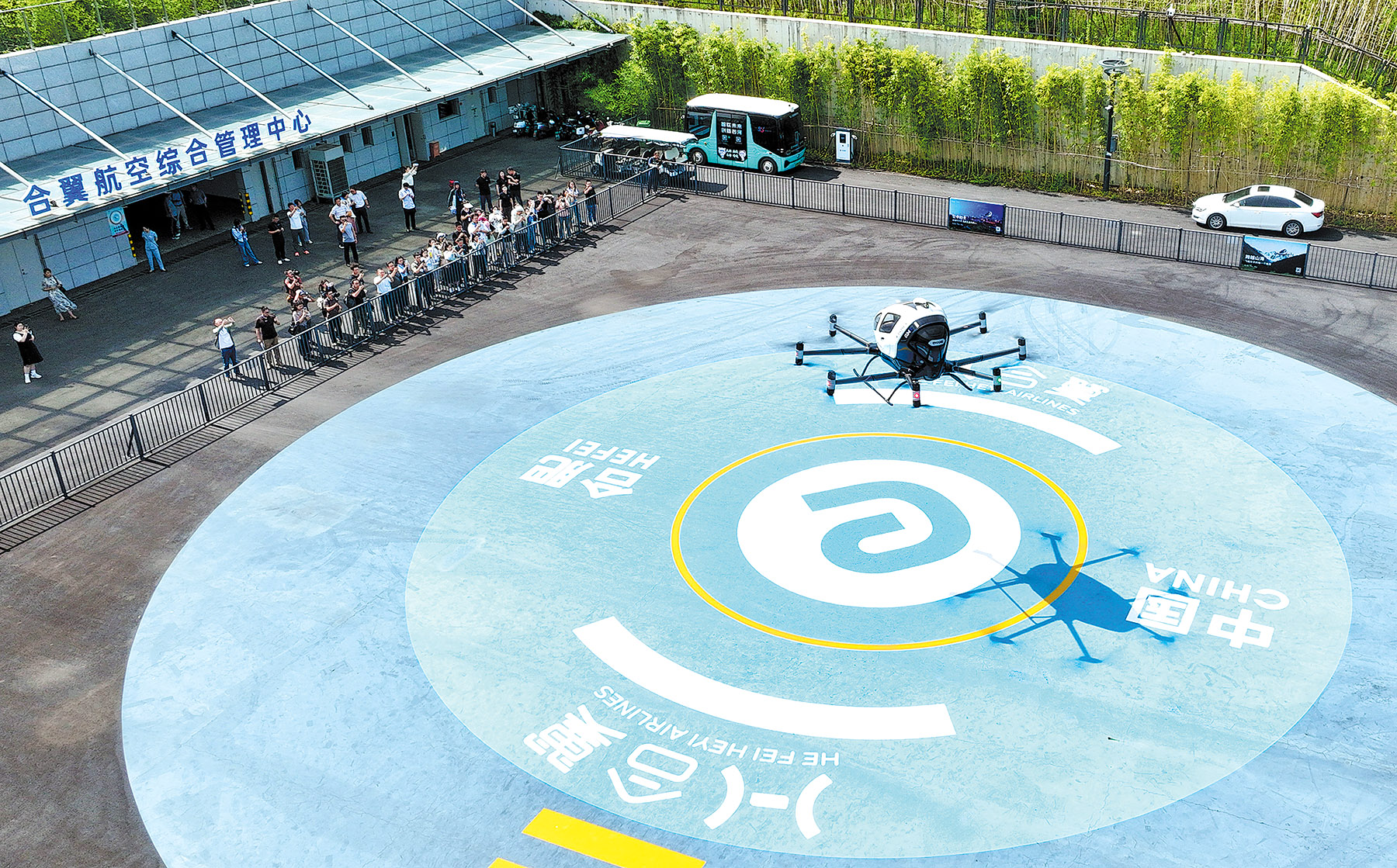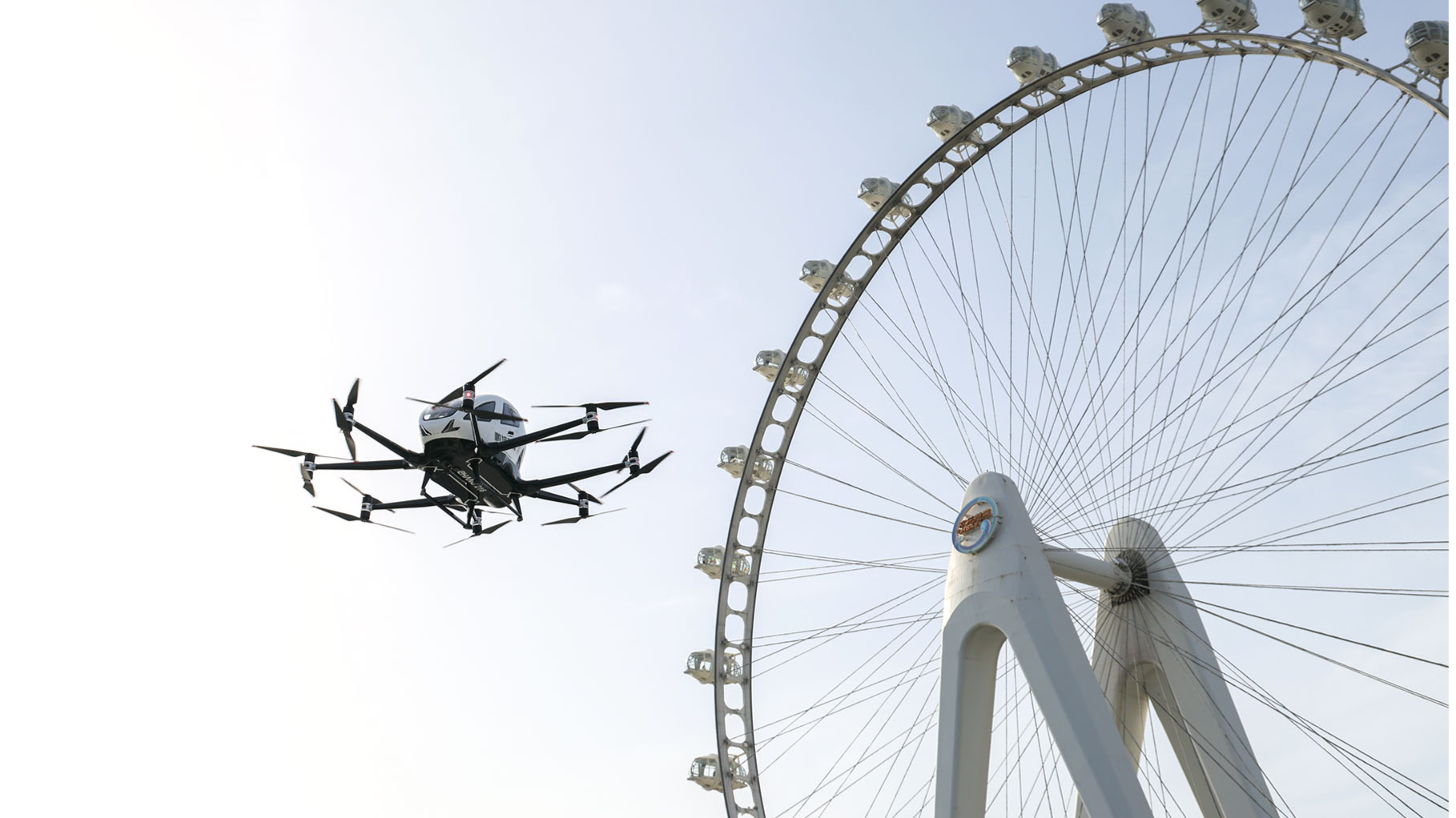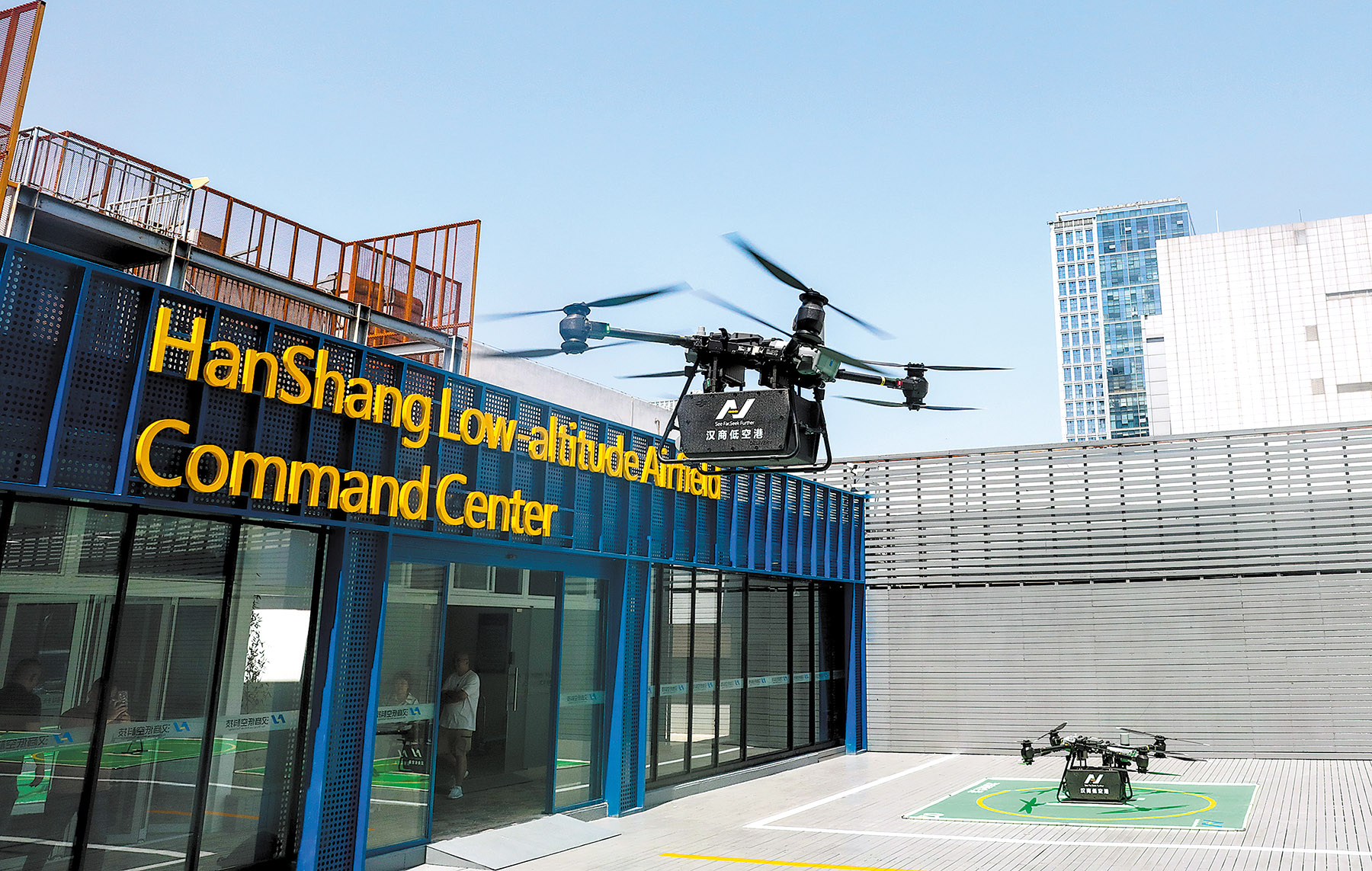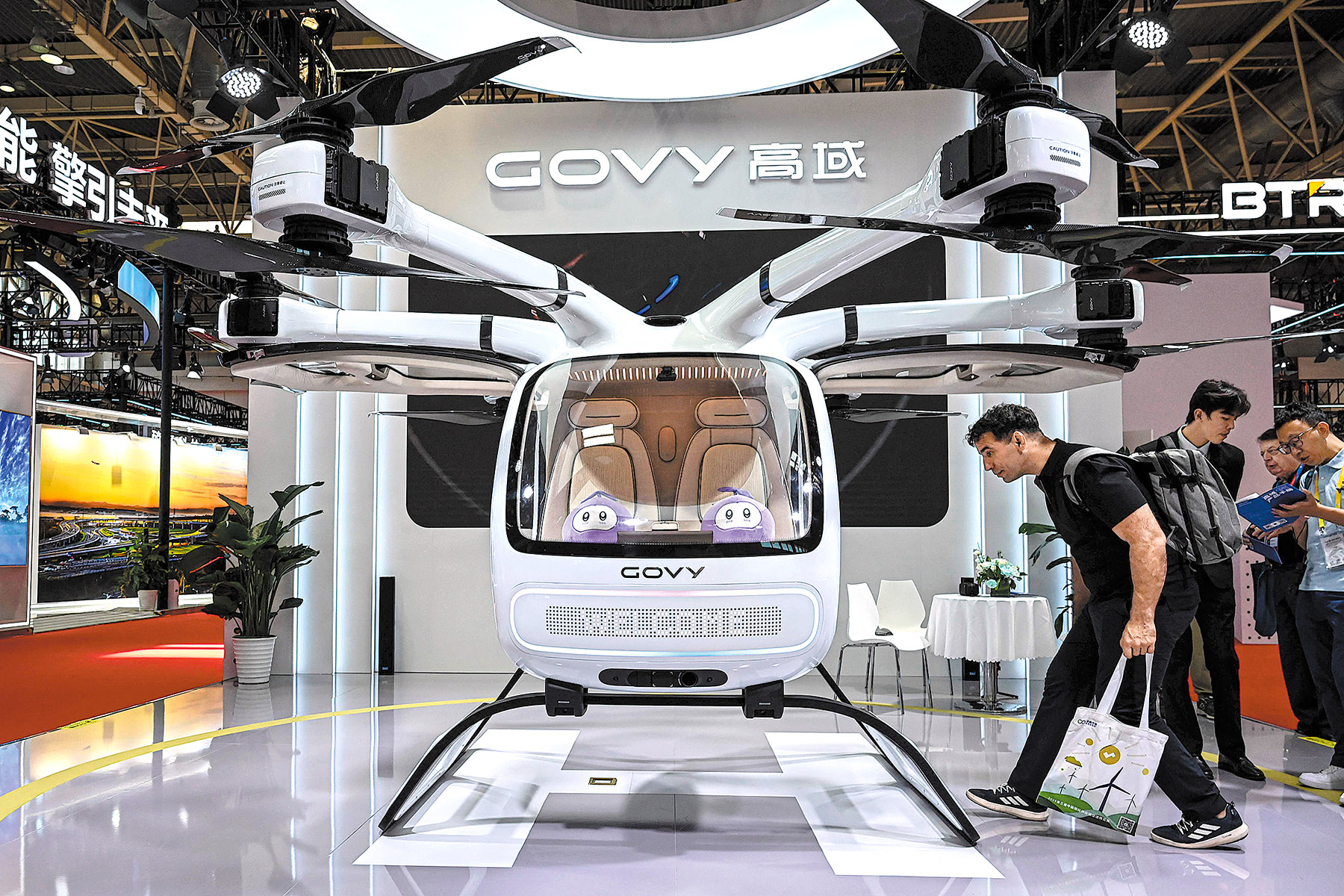Low-altitude economy looks set for robust growth amid wider drone use in tourism, logistics and agriculture sectors to help improve people’s lives in China

Booking “air taxis” for intercity commuting and sightseeing tours, and drones making food and parcel deliveries are no longer scenarios from the future. They are already gradually becoming part of everyday life for people in China.
The nation’s low-altitude sector — regarded as a strategic emerging industry — is poised to see robust growth in the coming years.
Experts said this is fueled by commercial applications across a wide range of fields — including passenger transportation, tourism, agriculture, and logistics — coupled with supportive measures from authorities.
Sharper focus on developing the low-altitude economy will alleviate urban traffic congestion and foster new economic growth drivers, as the sector realizes immense development potential, they added.
However, more efforts should be made to improve rules and regulatory policies regarding the safe operation of unmanned aerial vehicles and other low-altitude flight activities, the experts said. The construction of ground infrastructure — including takeoff and landing sites, as well as maintenance centers — should also be accelerated.
The market scale of China’s low-altitude economy will reach 1.5 trillion yuan ($209.9 billion) in 2025 and rise to 3.5 trillion yuan in 2035, according to data from the Civil Aviation Administration of China.
The low-altitude economy encompasses civil piloted and unpiloted aviation activities within an airspace extending up to 3,000 meters, and includes aircraft manufacturing, low-altitude flight operations, and integrated services.

Chinese manufacturers of unmanned aerial vehicles, also known as drones, are increasing efforts to boost the sector’s development and expand drone use in various fields, including aerial tourism, geological surveying and mapping, agriculture, public security, aerial logistics, and even disaster relief.
Urban air mobility technology company EHang Holdings is accelerating efforts to drive the commercial use of electric vertical takeoff and landing (eVTOL) aircraft in aerial sightseeing, tourism, and logistics.
Referred to as “air taxis”, eVTOL aircraft do not require traditional airports or runways. Similar to helicopters, they take off vertically and transition into fixed-wing flight mode in the air, and offer a promising air traffic and sightseeing experience while traversing congested big cities.
The Civil Aviation Administration of China (CAAC) has granted EHang one of the first “air operator” certificates for civil human-carrying pilotless aerial vehicles. The certification marks a significant step toward the commercialization and mass adoption of low-altitude human-carrying flight services.
Consumers will be able to purchase flight tickets for low-altitude tourism and urban sightseeing, and enjoy a range of commercial human-carrying flight services at sites in Guangzhou, Guangdong province, and Hefei, Anhui province.
Hu Huazhi, EHang’s founder, chairman, and CEO, stated that the low-altitude economy and related sectors present a significant market opportunity for urban air mobility development, while also serving as a new engine for growth across China.
He added that the company hopes to introduce safe and reliable pilotless eVTOL aircraft and offer autonomous, eco-friendly air mobility services.

In June, EHang received a purchase order for 50 units of its EH216-S pilotless eVTOL aircraft from Guizhou Scenic Tourism Development Co. The aircraft will be deployed in scenic areas around Guizhou province to offer low-altitude aerial tourism and sightseeing services, while exploring low-altitude tourism opportunities.
In August, the company announced that its VT20, a logistics eVTOL, had successfully completed an intercity cargo delivery round-trip between Zhuhai and Guangzhou in the Guangdong-Hong Kong-Macao Greater Bay Area.
The groundbreaking flight covered 83 kilometers and lasted approximately 55 minutes. This significantly enhances logistics efficiency between the two cities in Guangdong province, saving up to 40 minutes compared with road transportation and over an hour during traffic congestion periods, the company said.
According to a report by market research company CCID Consulting, China’s eVTOL industry is set to maintain rapid growth over the next few years, with the market size reaching 9.5 billion yuan in 2026, driven by the speedy issuance of airworthiness certifications by authorities.
Global market consultancy Roland Berger has estimated that there will be up to 3,000 air taxis in operation worldwide by 2025 — a figure which will increase exponentially to 100,000 by 2050.
Yu Zhanfu, a partner at Roland Berger, said that compared with traditional helicopters, eVTOL aircraft are smaller, lighter, and require less space for takeoffs and landings. They also have lower operating costs, which will give a big boost to their popularity.
The low-altitude economy, which plays a key role in nurturing new-quality productive forces and serves as a new growth engine, was written into the government work report for the first time last year.
Currently, around 30 provincial-level regions across the nation have included bolstering the development of the low-altitude economy in local government work reports and rolled out relevant policies.

Both Guangzhou and Shenzhen in Guangdong province and Hefei in Anhui province have implemented favorable policies, such as providing subsidies and incentives, to facilitate the development of the low-altitude economy and build up related industrial clusters to gain a competitive edge in the emerging industry.
China aims to establish a new development model for the general aviation industry characterized by high-end, intelligent, and green features by 2030, and form a trillion-yuan general aviation equipment market, according to an action plan issued by the Ministry of Industry and Information Technology and three other government departments.
By 2027, new-generation general aviation equipment featuring unmanned, electric, and intelligent elements will be commercially applied in urban air transportation, logistics distribution, and emergency rescue work, the plan said.
DJI, the world’s largest commercial drone manufacturer by market share, has invested heavily in industrial drones that can be used in various sectors, including agriculture, electricity, petroleum pipeline inspections, mapping, and transportation, creating great economic and social value.
The emergence of industrial drones has reshaped people’s lives and production models, as well as promoted the development of diverse industries, said Zhang Xiaonan, DJI’s director of senior corporate strategy and spokeswoman.
Though such drones are still in the initial stage of development, their applications will be more extensive in the future as related technologies advance, Zhang added.
The company has also made forays into the delivery and logistics sector by unveiling its cargo drones. The drones have transported daily supplies, photovoltaic panels, building materials, and emergency supplies to mountainous regions and rural areas, improving transportation efficiency and relieving labor shortages.
“We are bullish on the prospects for aerial transport and hope to effectively solve the challenges arising from complex terrain and last-mile transportation for the industry,” Zhang said.

In addition, DJI drones carried out three-dimensional digitalization of national cultural heritage, making contributions to the preservation, restoration, and research of cultural heritage and historical relics. Its drones have also been used for public safety, firefighting, and emergency rescue.
The Shenzhen-based company expects to further promote the use of drones in all walks of life, Zhang said.
The Chinese government has issued several policies to promote modern agricultural machinery, boosting drone use in agriculture.
Farming drones have been widely used for spraying pesticides, sprinkling fertilizers, and sowing seeds to help farmers improve efficiency and reduce costs, said Justin Gong, co-founder of XAG Co, one of China’s largest agricultural drone manufacturers.
“Our ultimate goal is to create a smart agriculture ecosystem in which all the repetitive, tedious, and dangerous jobs are assigned to drones and robots, allowing farmers to focus on decision-making with the aid of big data and artificial intelligence,” Gong said.
Instead of directly selling the devices to farmers, the company has trained many young people who returned to the countryside as drone pilots, he said, adding that digital technologies help accelerate the industrialization of the country’s agricultural sector.
DJI has also devoted a great deal of attention to agricultural drones to help farmers improve the efficiency of sowing seeds and spraying fertilizers and pesticides, and increase the use of intelligent agricultural equipment.
As of October 2024, DJI’s agricultural drones had been sold in more than 100 countries and regions, with accumulated sales reaching 400,000 units worldwide.
“With the expansion of application scenarios and innovation of service models, the scope of the low-altitude economy is becoming increasingly broad, ranging from agriculture and aerial photography to urban air mobility, logistics, and delivery,” said Yang Jincai, director of the Shenzhen Unmanned Aerial Vehicle Industry Association.
In China, the sector is still in its initial development stage, and there is a lack of effective supervision and emergency response mechanisms regarding low-altitude flight activities, presenting difficulties for urban low-altitude airspace management, he said.
Yang called for greater efforts to improve the design and planning of low-altitude airspace to fully use airspace resources and meet the needs of various aviation activities, while strengthening supervision and management of flight activities.

Yang Ling, general manager of the intelligent equipment industry research center of CCID Consulting, said that as low-altitude flight activities continue to increase, more capital will be put into the construction of low-altitude infrastructure. “China’s low-altitude economy is expected to maintain rapid growth,” he said.
He said China’s technological advancements and expertise in areas such as electric vehicles, batteries, and rail transit provide strong technical support for the research and development of drones.
Delivery drones have become increasingly widespread in recent years. Chinese e-commerce giant JD has used drones to reach consumers in hard-to-reach remote areas.
The drones take off from regional delivery stations, follow a predetermined route to villages or rural areas, land at designated drop-off points, and give orders directly to customers, significantly shortening delivery time and reducing logistics costs.
Food delivery platform Meituan has made great strides in drone usage. The company announced in April that its self-developed fourth-generation drone has passed a CAAC review and obtained the country’s first operating certificate for low-altitude logistics nationwide.
The license allows Meituan’s drones to begin regular commercial drone delivery services nationwide. The company has opened 64 drone delivery routes in major cities and completed over 600,000 orders.
The service offers customers a wide selection of products and spans a variety of locations, ranging from offices, residential areas, and libraries to tourist spots.
In the global delivery drone market, the Asia-Pacific region will witness the highest growth, while China has been the largest market, according to a report from market research company Mordor Intelligence.
Increasing support from authorities responsible for commercial drone operations is propelling the growth of drone delivery operations in the region, the report added.
Courier and logistics company SF Holding has rolled out a range of delivery drones with a maximum payload of 25 kilograms and a maximum flying distance of 100 km.
Zhu Keli, founding director of the China Institute of New Economy, said: “The low-altitude economy has entered a golden period of development, with its applications continuously expanding in areas such as logistics and tourism, which will drive the coordinated development of related industrial chains.”
“The low-altitude economy industrial chains encompass low-altitude aircraft manufacturing, operational services, airspace management, airworthiness certification, quality supervision, and safety management,” he said.
Zhu emphasized the significance of strengthening the development and utilization of low-altitude airspace resources and accelerating the establishment of supporting infrastructure.
It is of vital importance to improve airspace management policies, reinforce policy support and guidance, encourage enterprises to increase investment in R&D and technological innovation, and strengthen the formulation of regulatory policies, Zhu added.
Yang Sumei, an associate professor at Guangzhou Maritime University, said the low-altitude economy serves as an important driving force for cultivating new-quality productive forces and has huge market potential.
More efforts should be made to establish applicable rules and standards to better regulate the fast-developing sector and advance the construction of low-altitude infrastructure, intelligent management, and operating platforms, Yang said.
Contact the writers at fanfeifei@chinadaily.com.cn


